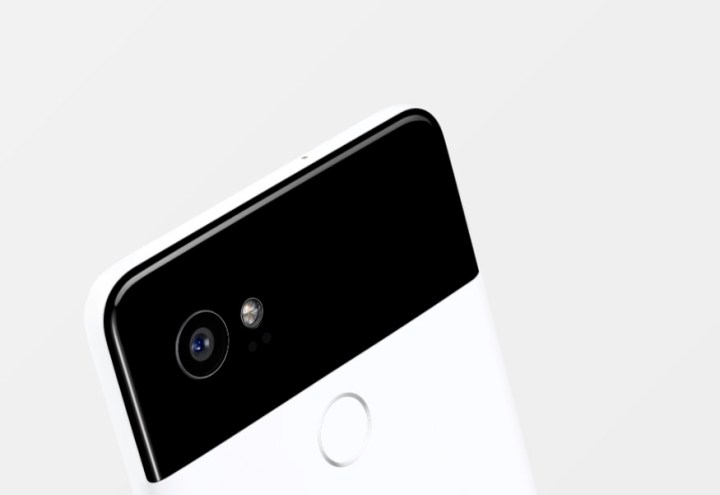
Its camera was one of the many highlights of the original Google Pixel, but with machine learning and updated hardware, Google is taking its photo game up a notch with a number of firsts in the new Google Pixel 2 and Pixel 2 XL. Announced on October 4 during an event in San Francisco, the Google Pixel 2 camera sports background blur without a second camera, dual optical and electronic image stabilization, automatic HDR and augmented reality stickers inside the native camera mode. Oh, and with a rating of 98, the Pixel 2 also earns the highest rating for any smartphone camera yet from DxOMark.
The updates stem from Google’s focus on mixing machine learning, hardware, and software across its entire line of new products. Machine learning is responsible for a number of the Pixel 2’s new features. First, the Google Pixel 2 includes a portrait mode that, like the last few iPhone Plus phones, simulates background blur that more closely resembles the photos shot from a DSLR, rather than a small sensor smartphone. The difference? Pixel 2 doesn’t need two cameras to do it.
Instead of creating a 3D depth map by comparing the different views from the two different locations, Pixel 2 uses a dual pixel sensor, comparing the right and left sides of the pixel to determine what objects are close to the camera and what is in the background. Machine learning software then applies the blur effect to the background. According to Google’s Aparna Chennapragada, the system is very accurate, even with busy backgrounds or when photographing an object instead of a person.
Besides the fact that the one-camera requirement means the feature is available without moving to the larger phablet-sized XL, the portrait mode is also available with the front-facing camera in the Pixel 2.
Computational photography is also responsible for the Pixel 2’s boost in photo quality using an automatic HDR. When a photo is shot on the Pixel 2, the camera takes several images at slightly different exposure levels, then aligns them via software on a pixel-for-pixel basis. With the data from multiple files, the resulting image contains more detail in the lightest and darkest areas of the image. Chennapragada says that all of this happens instantly, with no shutter lag between shots as the smartphone processes the files.
Both hardware and computational photography are also responsible for the Pixel 2’s boost in low light stills and video. Dubbed Fused Video Stabilization, the Pixel 2 essentially uses both the optical stabilization, the hardware-type system that doesn’t create a loss in image quality, and electronic stabilization, which measures any remaining shake and crops the footage to steady the shot.
Besides capturing the real world, the Google Pixel 2 includes built-in augmented reality stickers. While AR stickers are growing in popularity in apps like Snapchat and Facebook Camera, the Pixel 2 is the first mainstream smartphone to our knowledge to include AR inside the native camera mode instead of a third-party app. The AR stickers, which range from emojis to characters from movies including Stranger Things and Star Wars, aren’t just placed in the scene but move around. Place two stickers, and they’ll even interact with each other.
Google says that factors like emotions, physics, and even the lighting in the scene all blend together to make the virtual characters feel like part of the scene. “Now you can be the director of all kinds of stories and share these with friends,” Chennapragada said. “…The stickers are so easy to use and they look great because the Pixel camera is specially calibrated for AR with pixel tracking and 60 fps. The camera can bridge the physical and digital with AR.”
The Pixel 2 also features a motion photos mode, a shooting style that captures three seconds of video behind the scenes.
The Pixel 2’s camera specs are rounded out with a 12.1-megapixel sensor paired with an f/1.8 lens and an updated, dual pixel autofocus system. The front-facing camera uses an eight-megapixel sensor.
All those features factor into the Pixel 2’s DxO score of 98, the highest score yet from the third-party camera testing company for any smartphone. Last month, DxO Mark updated its testing for smartphones to include factors like the artificial background blur from portrait mode. While the updated guidelines suggest that the Pixel 2 has one of the best cameras for smartphones, the guidelines don’t directly compare it under the rest of DxOMark’s tests, so the Pixel 2’s score of 98 doesn’t compare to the same 98 earned by the full frame Sony a7R II.
The Pixel 2’s camera will also come into play for more than just shooting photos — a preview of Google Lens, an artificially intelligent computer-vision program, is built into the Google Photos and Google Assistant native apps. The feature allows users to snap a photo of a flyer and copy and paste an email address or phone number without retyping, and to discover more about art, movies, books and music by snapping a photo.
All those features suggest users will be taking a lot of photos with the Pixel 2 — but the included Google Photos app also now gives Pixel 2 owners free, unlimited photo storage. The app also uses an automatic tagging system, making all those photos easy to search through.
Pricing for the Google Pixel 2 starts at $649, with the XL starting at $849.


